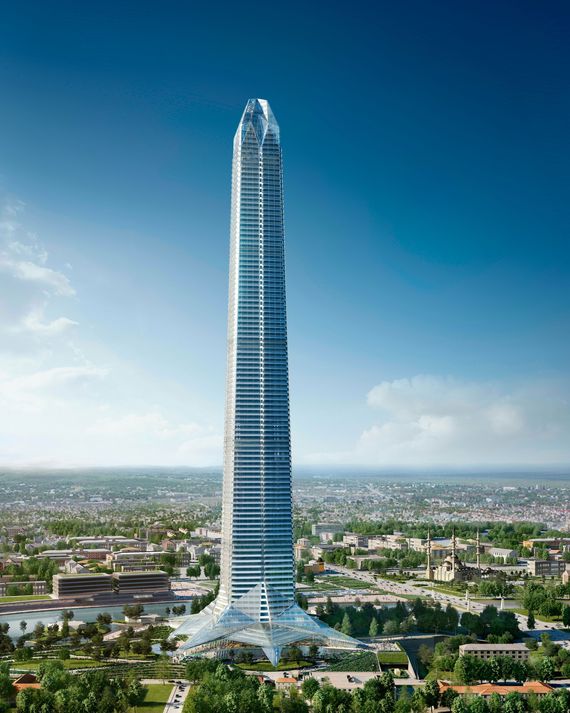
Weeks after Russian forces had pulled out of the Kyiv suburb of Irpin, leaving a trail of unburied bodies, blasted homes, and booby-trapped rubble, a more peaceable force rolled in: 120 architects from all over Ukraine, summoned to figure out what to rebuild first and how to do it. Among them was a team from Archimatika, a Kyiv firm trying to reconcile two competing priorities: replacing what’s broken right away, and making Ukrainian cities better than they were. “We need to build housing quickly and cheaply, but it has to be nice, and not just for a few years but for the future,” says the firm’s co-founder Aleksandr Popov. “We can’t make the same mistake we did after World War II, when we made so many very bad buildings.” By “we” he means the Soviet Union, and by “bad” he means the infamously drab, ostensibly temporary apartment blocks called Khrushchyovka still quietly crumbling in virtually every city from Tallinn to Vladivostok.
“Cheap, fast, and good” is never easy to achieve — the old saw says you can have any two but never all three — and here it’s made harder by Russian missiles that continue grinding some cities into fields of rubble even as volunteers patch damaged buildings by hand, workers restore utilities, and residents clear streets. The daily images of destruction become all the more poignant when you flip through photos of the same spots taken just weeks ago and find shoe-store sales, stately theaters, effervescent cafés, traffic jams. In the video that Volodymyr Zelenskyy’s brilliant propagandists assembled to show Congress, the “before” is vivid, colorful, and in high resolution, and the “after” is bleak, blurred, and washed out.
Zelenskyy is thinking ahead. He’s called for a new Marshall Plan and even floated a preliminary price tag of $600 billion. Nearly 70 percent of Ukrainians live in cities, and now they have a chance to give concrete expression to the abstraction they’ve all been fighting for: a national identity. For now, the choice, in architecture as in politics, is to look toward Russia or toward Europe. The British doyen of high-tech global cool, Norman Foster, has already begun assembling a brain trust to plan a reborn Kharkiv, an offer that irks some Ukrainian architects. But whether through international or homegrown effort (or, more likely, both), reconstruction will be tangled up with intangible but crucial issues of culture and affiliation. In past centuries, similar tensions have yielded the German, Italian, and Eastern European layers of Lviv’s old town or Odesa’s ornate neoclassical palaces.
One unmissable sign of Kyiv’s long pro-western drift is Archimatika’s recently completed Comfort Town, an immense gated development of ice-cream-colored apartment buildings set around landscaped courts. Located on the site of a notoriously polluting rubber-recycling plant, it’s both a deliberate anomaly and an update of the ubiquitous mikrorayoni (isolated residential districts similar to American housing projects, but with their own schools, shops, and public buildings). The surrounding area is a Soviet holdover, gray, run-down, weedy, and working-class. Inside the gates, a younger, (slightly) more affluent population enjoys the freedom of a campuslike enclave with playgrounds, tennis courts, an ornamental miniature windmill, and private security guards. More crucially, the architects have squeezed enough different configurations out of 1,000 square feet that a household can grow even if its budget doesn’t. A 2018 study of the relationship between residents on either side of the fence suggested that the complex offers a vision of Kyiv’s non-Russian future by invoking an idealized western past. Old-guard neighbors see it as a curious but irrelevant incursion. The buildings, the study’s authors write, appear as “colorful beacons of Europeanness towering out of the dark anachronism of the Soviet city.”
Comfort Town could be a harbinger or a dead end. For Roman Cybriwsky, a retired Temple University professor of geography and urban studies and author of Kyiv, Ukraine: The City of Domes and Demons from the Collapse of Socialism to the Mass Uprising of 2013–2014, it’s both. Cybriwsky is skeptical that peace will bring a new era in urbanism. Comfort Town, he says, “really isn’t anything new, except for the use of paint. The buildings are different colors, which looks nice in photographs, but they’re basically the same crap that exists everywhere.” That’s what the postwar future portends, too, he thinks: Immediate needs and a cultural distaste for innovation will reinforce the same old shoddiness, possibly dressed up in pastels.
There is a glitch in Cybriwsky’s theory of foreordained continuity, though. Ukraine now has no choice but to find a way around its dependence on Russia’s oil and gas. Two months of violence have revealed what years of climate-consciousness-raising and sober planning couldn’t: A steady supply of fossil fuels can be a terrible trap. Getting out of it will mean nudging Ukrainians away from cars and toward renewable energy, a national imperative that will surely shape future cities. Kyiv’s extensive public-transit system hasn’t managed to tame the encroachment of cars. The city’s 3.5 million inhabitants owned 1.5 million cars as of 2015 (roughly double New York’s car-to-human ratio) and competed for a total of 25,000 legal parking spaces. The losers in this game of musical parking cram onto sidewalks and into squares, parks, and playing fields.
Cities organized around private automobiles aren’t merely ugly; they’re inhumane, and Ukrainians have gotten a close-up view of their lethality. Russian tanks, paid for and fed by Russian oil, arrive on roads built for cars and trucks, cross bridges engineered to carry cars and trucks, and fire from boulevards wide enough for cars and trucks, killing civilians in their cars and trucks. Those hoping to raise a new nation out of the ashes of the old might think strategically about laying new plans over old maps. A low-carbon Ukrainian metropolis could grow inward rather than up or out, with bicycle paths, alleys, footbridges, courtyards, arcades, and riverside esplanades as connective tissue. That’s one way of asserting independence from fossil-fuel servitude.
This isn’t Ukraine’s first destruction — or reconstruction. The German invasion during World War II left Kyiv an ash heap that the Soviet Union rebuilt in its own image, from neoclassical palaces to the Motherland Monument to Soviet war heroes. Ironically, the current onslaught is wiping out much of that Cold War grandiosity. At the Azovstal Steel Plant in Mariupol, Putin’s forces have spent weeks trying to pulverize the pride of Stalin’s industrial might. Russia is trying to conquer a nation it once dominated and at the same time is erasing the traces of its own control.
This isn’t Putin’s first obliteration campaign, either. That would be Grozny, the capital of Chechnya, which he ordered the Russian military to level in the 1990s. That time, once the insurgency had been stamped out and a puppet, Ramzan Kadyrov, safely installed as local leader, Moscow rebuilt what it had destroyed. The eight-lane Putin Avenue runs through the center, pointing toward a massive new mosque and the high-rise Grozny City development. Still in the works for Grozny is the skyline’s planned capstone, the 1,400-foot Akhmat Tower designed by the Chicago super-skyscraper experts Adrian Smith and Gordon Gill. (“There will be lobbies, offices, restaurants, a ballroom, a five-star hotel, serviced apartments, fitness and spa complex, residences, penthouses, observation deck and exhibition hall,” the developer’s website promises.) Grozny has a population the size of Buffalo’s; applying that kind of grandiosity to Ukraine’s much larger cities would likely yield a trillion-dollar gift to Putin’s obedient developer-plutocrats.
To Archimatika’s Popov, the key to avoiding either Soviet drear or Putin glitz is first, to win the war, and second, to make decisions today that don’t foreclose long-term ambitions. House returning refugees in apartments that can later accommodate a vibrant, fluid society. Replace Irpin’s shattered bridges with structures capable of carrying monorails, although it may be years before the tracks can be laid. Set up high-quality-concrete plants to crank out precast panels that won’t crumble in the rain. Create a national planning program that doesn’t wind up miring the country in bureaucratic drabness — and, conversely, foster a robust arena for private development that doesn’t devolve into a rapacious free-for-all.
Archimatika is modeling the balancing act that Ukraine needs. Popov has gone on the road (I reached him in Limassol, Cyprus) to nurture the firm’s foreign projects and provide an income for its dispersed staff, while his partner Dmytro Vasyliev remains in Kyiv to focus on pro bono reconstruction projects. The pandemic-enforced experience of collaborating across time zones comes in handy now. So do 15 years of cogitating about how to shape a dynamic and technologically sophisticated new Ukraine, primed to absorb influences from points west. The firm recently completed Unit.City, a glass-walled tech hub in Kyiv that would look comfortably cool in the Brooklyn Navy Yard.
The world offers plenty of examples of post-annihilation architecture. World War II shattered Tokyo and Dresden and London, a 15-year civil war ravaged Beirut, and urban renewal chewed through a whole swath of American downtowns. The record of their reconstruction is wildly mixed, giving Popov and his peers a long list of mistakes to avoid. The more foreign investment and expertise converges on Ukraine, the greater the risk that it will embrace some terrible conventions of city-building. A predilection for wide roads and lonely tall towers transcends geography and political system — see Dallas, Abu Dhabi, Moscow, Panama City, or Manila. Today’s glittering skylines and vast avenues represent a philosophy based on the free flow of capital, an endless supply of fossil fuels, and a cavalier attitude toward climate change. In many parts of the world, the glass-and-highway template is also a manifestation of institutionalized corruption, top-down political power, rigid social structures, and disdain for the rough-and-tumble of life in the public square — everything an embattled young country wants to avoid.
Popov says his more swashbuckling colleagues might be tempted by the model of Rotterdam, a proving ground for just about every architectural fashion since World War II. “It’s a very heroic city to do this, but here it’s not possible to be so experimental.” Ukraine, he suggests, will have to sift carefully through its past to figure out its future, and sometimes the smartest move is to double back. He mentions the sumptuous Royal Palace in the center of Berlin, which was damaged by Allied bombing and later replaced by East Germany’s blocky glass Palace of the Republic. After reunification, that, too, was demolished, and a forward-looking, democratic, and ultramodern new Germany decided to reconstruct its old dome-topped symbol of monarchic rule. “Kyiv has a soul like Berlin,” Popov says. “And that’s okay. If I want to experiment, I just need to go to other cities.”






